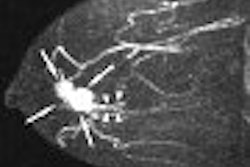This article written by Dr. Howard Forman, associate editor of health policy for the American Roentgen Ray Society (ARRS), originally appeared in the American Journal of Roentgenology.

CT and MRI utilization have increased for multiple reasons:
- Technology is advancing, bringing ever-increasing reasons for using the technology.
- Technology works -- patients are being diagnosed faster and better with presumed improvements in outcomes.
- New generations of physicians are trained with deeply held beliefs that imaging technology can help their patients, and they replace physicians who may have relied more heavily on physical examination and nontechnology-based diagnostic interrogations.
- Capacity has grown at a phenomenal rate.
- Healthcare is the best example of supplier-induced demand.
The expansion in capacity is important for a number of reasons. In the absence of insurance, we would be much more comfortable believing that demand is high and the market is meeting demand. But in healthcare, as we know, demand is difficult to truly measure; because the patient rarely bears the full cost of the study, it may be that demand is artificially high.
Furthermore, physicians may encourage demand for defensive medicine reasons or even financial self-interest. Finally, we have all witnessed instances in which examinations are ordered for marginal indications. If capacity is driving demand (supplier-induced demand), then we need to ask what may be driving supply.
One obvious reason why supply is expanding is the better use of equipment. Newer equipment is capable of faster and more efficient scanning, and institutions are better able to manage workflow, resulting in more efficient throughput. The notion of scheduling patients every hour or even every half hour (for CT studies) seems laughable today, yet a few years ago it was routine. Even in MRI, higher throughput has been enabled by better technology and workflow management.
Another reason for the increased supply is a better hospital-based reimbursement environment. In the years following the passage of the Balanced Budget Act of 1997 (see the August 2006 Policy Brief), hospitals have struggled to balance their budgets, and capital budgets were very tight with less room for error. In the early part of this decade, hospitals had some breathing room with their budgets and also found imaging to be an important service item for their patients and clinicians. Thus began an investment boom in imaging services.
Although members of our specialty have been reticent to admit it, a third major reason for the boom in capacity/supply has been the rewards of investing in new imaging facilities. In the past decade, there have been fewer "sure things" than an imaging facility.
Aside from some niche applications, such as whole-body self-referred imaging (Radiology, September 2004, Vol. 233:9, pp.353-358), investments in imaging centers have been very profitable. I am not referring to the professional fee component of such centers, but rather the technical component of imaging centers that typically include some combination of MRI, CT, and more frequently PET (often including CT). In the last two years, I have spoken to several private equity investors about this sector: investors who previously would have been looking at shopping mall development, hotel chains, or retirement communities. In each instance, nonhealthcare-minded funds with hundreds of millions of dollars in capital available were looking at investment opportunities in CT, MRI, and PET/CT. When these private equity investors did the accounting, they concluded that these opportunities seemed immensely profitable.
You may wonder why this should matter to you. In its June 2006 report ("A Data Book: Healthcare Spending and the Medicare Program"), MedPAC raised significant concerns about the reimbursement of MRI and CT. The Centers for Medicare and Medicaid Services (CMS) has typically used a cost-based methodology for reimbursement, and the technical component of imaging services is based on real cost inputs.
If this were done accurately, the reimbursement for the technical component would be very closely matched to the cost and, thus, there would be little reason to add imaging capacity, except to meet the needs of the community. If the reimbursement were set too low, one might find a shortage of capacity and access problems among beneficiaries. If the reimbursement were set too high, however, capacity might grow due to entrepreneurial and pecuniary motives.
I know there are many radiologists who believe that reimbursement for the technical component of MRI and CT is not too high; they may even believe it is too low. For certain practices, this may very well be the case: smaller, rural, older practices may, in fact, need a higher reimbursement to provide necessary services. I am not writing this brief to argue individual practice economics or even to convince you that reimbursement is too high, too low, or just right. MedPAC, however, has made a compelling case for why it believes that the current methodology used for calculating reimbursement for CT and MRI is too high.
MedPAC has pointed out two major areas of cost-reimbursement methodology that likely result in higher reimbursement than is necessary:
In calculating the equipment component of the technical reimbursement of CT and MRI services, CMS assumes that the CT or MR scanner is only being used 50% of the time the practice is operating. In assuming this, the average embedded cost of a scan is higher than it would be if the scanner were used 80% or 90% of the time. In MedPAC's own recent (self-admitted nonscientific and limited) survey of practices (June 2006), it found that the mean use rate for MRI was 91% and the mean use rate for CT was 73%.
Similarly, when calculating the cost-of-capital for MRI and CT (that being the cost of financing the equipment purchase or lease), CMS has assumed that the interest rate charged is 11%, an admittedly high rate.
When CMS modifies its assumptions to reflect a 75% use rate and a 6% interest rate, it results in a 40% reduction in the reimbursement for the equipment portion of the fee schedule; this would be much less than 40%, once all other components are included, but still rather large.
In the August AJR Policy Brief, I wrote about some very troubling already-enacted and scheduled-to-be-implemented changes that will adversely affect our reimbursement. The MedPAC report, on the other hand, is more cautionary. If MedPAC is wrong and practices are actually using their equipment at rates of 50% or less, then my question is why? Such equipment seems too valuable to be idle for more than half of the time. On the other hand, if the equipment is actually being used more than 50% of the time, then how can one prepare for the downward trend in reimbursement?
Last month, one of the investors I spoke with told me he had decided not to invest in the imaging facilities that he was looking at. That is just an anecdote, but resonated with me: Is the bubble in imaging facilities coming to an end, even before the downward spiral in reimbursement? What will this mean for rural, smaller, and older practices? Will patient access be an issue? With ever-increasing and evolving new technologies (particularly cardiac applications), will volume compensate for reimbursement?
Making a practice more efficient is but one step that can help. Self-referral is also a major threat to our success: If internally referring practices control the stream of patients, our own practices could become less efficient; and self-referred practices may simultaneously be providing poorer quality and driving up overall imaging costs. I would caution every radiologist to prepare his or her practice for a more rate-restrictive environment. At the same time (as I indicated in the August Policy Brief), it is imperative that radiologists get involved with educating their representatives at both the local and federal levels.
By Dr. Howard P. Forman
AuntMinnie.com contributing writer
September 20, 2006
Forman is an associate editor of health policy for the American Roentgen Ray Society (ARRS). This article originally appeared in the American Journal of Roentgenology (September 2006, Vol. 187:3, pp. 601-602). Reprinted by permission of the ARRS.
Related Reading
Radiology reimbursement faces major changes, August 21, 2006
Medicare 2006 and beyond: What comes after 'critical'? July 25, 2006
Copyright © 2006 American Roentgen Ray Society



















